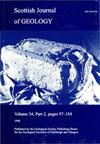苏格兰西南部Canonbie煤田晚石炭世层序的地震和钻孔测绘:华力西前陆断裂的证据?
IF 0.5
4区 地球科学
Q4 GEOLOGY
引用次数: 4
摘要
Canonbie煤田(苏格兰西南部)石炭系Pennine煤系和Warwickshire群序列的局部地震和钻孔测绘提供了正反转、同沉积褶皱和不整合的重复事件的证据。根据对NE向正反转构造和同生NNE向同沉积生长褶皱的叠加地震反射层几何形状,识别出东北-西南向转换挤压的Duckmantian(Westphalian B)期。Canonbie揭示的盆地历史与邻近的英格兰北部普遍接受的模型不一致,该模型表明沉降是由石炭纪晚期的裂谷后热沉降引起的。沃里克郡群演替中发现的晚威斯特伐利亚-斯蒂芬阶不整合意味着NW–SE,c.在晚石炭世华力西前陆的主要缩短时期,局部盆地缩短了10%,这与华力西最大缩短对英国北部石炭系盆地影响可忽略不计的说法相矛盾。局部倒转构造似乎强烈影响了局部晚威斯特伐利亚-斯蒂芬尼沉积中心。在这方面,Canonbie的华力西前陆可能类似于一个“破碎”的前陆系统。地壳流变学、断层强度和方向以及地壳中部分离的变化被认为在确定Canonbie煤田的应变局部化和威斯特伐利亚-斯蒂芬沉积中心的性质方面发挥了重要作用。本文章由计算机程序翻译,如有差异,请以英文原文为准。
Seismic and borehole-based mapping of the late Carboniferous succession in the Canonbie Coalfield, SW Scotland: evidence for a ‘broken’ Variscan foreland?
Local seismic and borehole-based mapping of the Carboniferous Pennine Coal Measures and Warwickshire Group successions in the Canonbie Coalfield (SW Scotland) provides evidence of repeated episodes of positive inversion, syn-depositional folding and unconformities. A Duckmantian (Westphalian B) episode of NE–SW transpression is recognized, based on onlapping seismic reflector geometries against NE-trending positive inversion structures and contemporaneous NNE-trending syn-depositional growth folding. The basin history thus revealed at Canonbie is at variance with generally accepted models in neighbouring northern England that imply subsidence was due to post-rift thermal subsidence during late Carboniferous times. A late Westphalian–Stephanian unconformity recognized within the Warwickshire Group succession signifies NW–SE, c. 10% local basin shortening during a time of major shortening in the late Carboniferous Variscan foreland, contradicting suggestions that maximum Variscan shortening had negligible impact on Carboniferous basins in northern Britain. Local inversion structures appear to have strongly influenced local late Westphalian–Stephanian depocentres. In this respect, the Variscan foreland at Canonbie may have resembled a ‘broken’ foreland system. Variations in crustal rheology, fault strength and orientation, and mid-crustal detachments are suggested to have played important roles in determining strain localization and the nature of Westphalian–Stephanian depocentres in the Canonbie Coalfield.
求助全文
通过发布文献求助,成功后即可免费获取论文全文。
去求助
来源期刊

Scottish Journal of Geology
地学-地质学
CiteScore
1.70
自引率
0.00%
发文量
10
审稿时长
>12 weeks
期刊介绍:
Although published only since 1965, the Scottish Journal of Geology has a long pedigree. It is the joint publication of the Geological Society of Glasgow and the Edinburgh Geological Society, which prior to 1965 published separate Transactions: from 1860 in the case of Glasgow and 1863 for Edinburgh.
Traditionally, the Journal has acted as the focus for papers on all aspects of Scottish geology and its contiguous areas, including the surrounding seas. The publication policy has always been outward looking, with the Editors encouraging review papers and papers on broader aspects of the Earth sciences that cannot be discussed solely in terms of Scottish geology.
The diverse geology of Scotland continues to provide an important natural laboratory for the study of earth sciences; many seminal studies in geology have been carried out on Scottish rocks, and over the years the results of much of this work had been published in the Journal and its predecessors.
The Journal fully deserves its high reputation worldwide and intends to maintain its status in the front rank of publications in the Earth sciences.
 求助内容:
求助内容: 应助结果提醒方式:
应助结果提醒方式:


